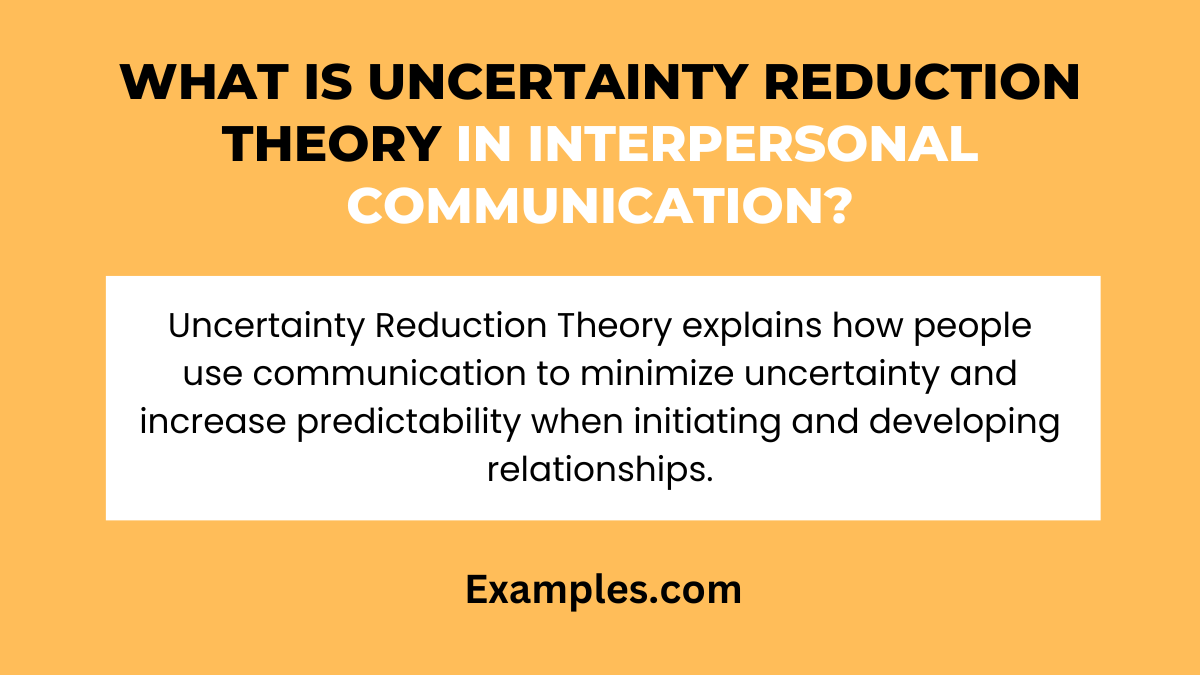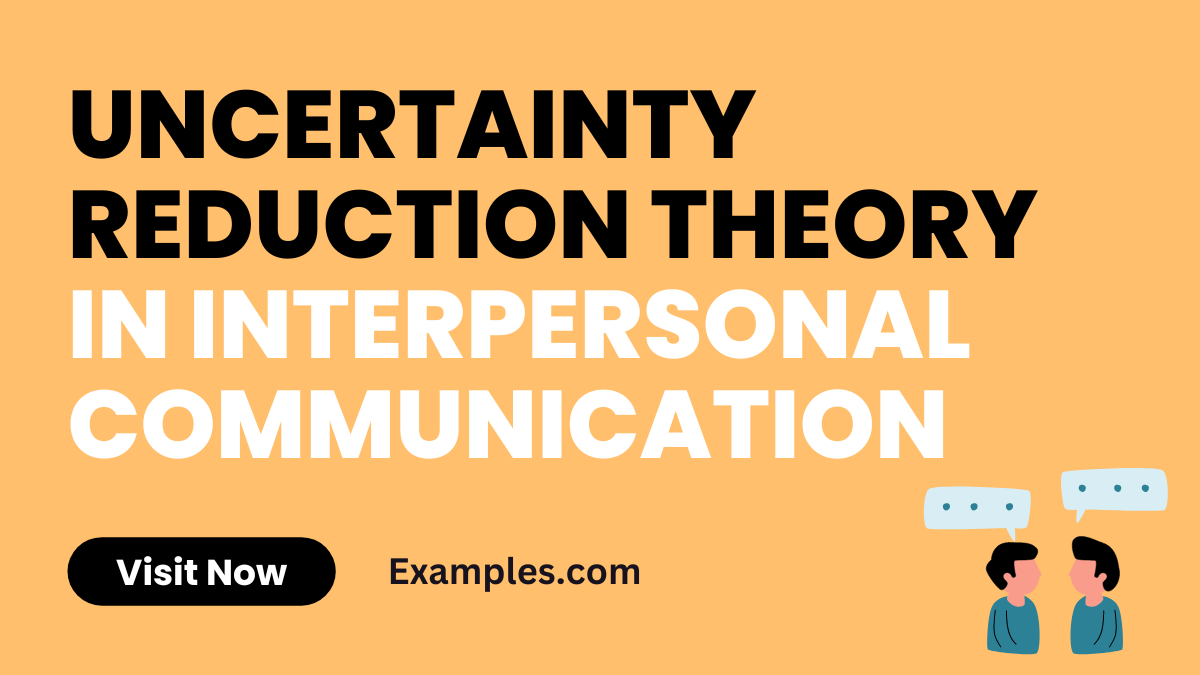Uncertainty Reduction Theory in Interpersonal Communication
Uncertainty Reduction Theory plays a pivotal role in Interpersonal Communication, offering insights into how individuals reduce uncertainty about each other to form meaningful connections. This comprehensive guide delves into practical applications of the theory in everyday interactions. By understanding and applying key principles, one can navigate complex social landscapes with greater confidence and effectiveness. This guide, enriched with real-life examples, is an essential resource for anyone looking to enhance their communication skills and build stronger relationships.
What is Uncertainty Reduction Theory in Interpersonal Communication?

Uncertainty Reduction Theory in Interpersonal Communication is a conceptual framework that explains how individuals gather information to reduce uncertainty about others during initial interactions. This theory posits that when two people meet, their primary goal is to reduce uncertainty about each other. This is achieved through various forms of communication, including verbal and non-verbal exchanges, leading to increased predictability and understanding in interpersonal relationships.
History
Who Created: Charles Berger
Date: 1970
Berger’s work was grounded in the idea that when individuals interact, their primary concern is to reduce uncertainty about each other. This theory has since become a cornerstone in the study of Interpersonal Communication, influencing numerous other theories and practices. It underscores the importance of communication in forming, developing, and maintaining human relationships, highlighting the role of information exchange in reducing uncertainty and building stronger interpersonal connections.
What is the Best Example of Uncertainty Reduction Theory in Interpersonal Communication?

One of the best examples of Uncertainty Reduction Theory in Interpersonal Communication involves meeting a new coworker. Initially, there might be uncertainty about their personality, preferences, and working style. To reduce this uncertainty, individuals engage in conversations, asking questions, and observing non-verbal cues. Over time, this active information-gathering leads to a better understanding of the coworker, facilitating a more comfortable and effective working relationship.
20 Examples of Uncertainty Reduction Theory in Interpersonal Communication

Uncertainty Reduction Theory plays a pivotal role in enhancing Interpersonal Communication. This theory, a cornerstone in Interpersonal Communication Skills, emphasizes how individuals gather information to reduce uncertainty in interactions. Understanding this theory is crucial in varied contexts, from professional settings to personal relationships. It aids in predicting and explaining communication patterns, emphasizing the importance of verbal and non-verbal cues. Here, we explore 20 unique examples demonstrating the practical application of this theory in everyday communication scenarios.
- Asking Open-Ended Questions: This approach encourages detailed responses, reducing uncertainty by acquiring more information about the person’s interests and values.
Example: “What motivates you in your career?” - Observing Non-Verbal Cues: This observation helps to adapt your communication style to be more reassuring.
Example: Noticing a colleague’s anxious body language during a meeting. - Engaging in Small Talk: Small talk about common interests helps build a rapport and reduces uncertainty in new relationships.
Example: “I noticed you like hiking. What trails do you recommend?” - Active Listening: Active listening demonstrates empathy and understanding, fostering a clearer communication channel.
Example: “I understand you’re concerned about the project timeline. Let’s discuss potential solutions.” - Sharing Personal Experiences: Sharing experiences can create common ground and lessen uncertainty in problem-solving situations.
Example: “I faced a similar challenge last year. Here’s how I managed it.” - Seeking Clarification: Asking for more details helps in understanding the context better, reducing misunderstandings.
Example: “Could you elaborate on your last point?” - Using Digital Communication Effectively: Digital communication, when used effectively, can reinforce understanding and reduce uncertainty post-interactions.
Example: Sending a clear, concise email summarizing a meeting. - Expressing Emotional Intelligence: Acknowledging and addressing emotions helps in navigating uncertain social dynamics.
Example: “I sense that you’re upset about the changes. Let’s talk about it.” - Cultural Sensitivity in Communication: Understanding cultural differences aids in reducing misunderstandings in diverse environments.
Example: “How does your culture view this issue?” - Feedback Seeking: Seeking feedback opens avenues for understanding others’ perceptions and expectations.
Example: “How did you find my presentation? Any areas for improvement?” - Utilizing Visual Communication: Visual aids can clarify concepts, reducing uncertainty in information transmission.
Example: Using graphs to explain complex data in a presentation. - Adapting Communication Style: Adapting style according to the listener’s preference decreases uncertainty in how the message is received.
Example: Switching from formal to informal tone based on the audience. - Practicing Empathy: Empathy builds a deeper understanding, fostering a more open communication environment.
Example: “I can see why that would be frustrating for you.” - Establishing Common Ground: Finding common interests lays a foundation for more predictable and comfortable interactions.
Example: “We both have a passion for environmental conservation.” - Respecting Boundaries: Respecting personal boundaries helps in maintaining a comfortable level of uncertainty in relationships.
Example: “I respect your privacy on this matter. Let me know if you ever want to talk.” - Consistent Communication: Consistency in communication patterns reduces uncertainty in team dynamics and expectations.
Example: Regular team meetings to discuss project progress. - Utilizing Public Communication: Effective public communication can establish credibility and reduce uncertainty in group settings.
Example: Addressing a group confidently during a public speaking event. - Conflict Resolution Techniques: Addressing conflicts directly reduces uncertainty and paves the way for clearer future interactions.
Example: “Let’s find a middle ground that satisfies both our concerns.” - Mentoring and Guidance: Offering guidance based on personal experiences can help reduce uncertainty in learning new skills.
Example: “From my experience, here’s a strategy that might work for you.” - Reflecting and Adapting: Reflecting on past communications and adapting based on those insights reduces uncertainty in similar future scenarios.
Example: Post-conversation reflection to improve future interactions.
Uncertainty Reduction Theory in Interpersonal Communication in Real Life
The Uncertainty Reduction Theory focuses on reducing unknowns in Interpersonal Communication. This theory highlights how individuals gather information to lessen uncertainty in real-life interactions, emphasizing the role of questions, observation, and non-verbal communication. It’s crucial in understanding interpersonal dynamics.
- Asking Direct Questions at a New Job: To reduce uncertainty, a new employee asks colleagues about company culture. This verbal interaction aids in understanding workplace dynamics.
- Observing Body Language on a First Date: One notices their date’s nervous gestures. Recognizing these non-verbal cues helps assess comfort levels and adjust behavior accordingly.
- Reading Online Profiles before a Meeting: Before a business meeting, one reads LinkedIn profiles of attendees. This written communication helps anticipate topics and reduces uncertainty about their backgrounds.
- Active Listening in a Therapy Session: A therapist listens attentively to a client’s tone and words, gaining insight into their emotional state. This effective listening is vital for understanding and reducing uncertainty.
- Analyzing Visual Aids during a Presentation: In a group meeting, visual aids like charts are used to clarify points, aiding in reducing misunderstandings and increasing clarity in small group communication.
- Sharing Emotions with a Close Friend: Expressing feelings openly with a trusted friend helps reduce uncertainty about each other’s emotional states, enhancing emotional expression in communication.
- Public Speaking at an Event: A speaker engages with the audience through eye contact and interactive Q&A, reducing uncertainty and fostering connection in public communication.
- Sending Clear Emails in a Project: To avoid confusion, a project manager uses concise and clear language in emails, ensuring effective digital communication among team members.
- Discussing Boundaries in a Relationship: Couples discuss their needs and boundaries, reducing uncertainties and conflicts through interpersonal conflict communication.
- Watching Educational Videos to Understand a Concept: Students watch videos to grasp complex topics, using visual communication to reduce uncertainty about academic concepts.
What is the Purpose of Uncertainty Reduction Theory in Interpersonal Communication?
Uncertainty Reduction Theory plays a pivotal role in Interpersonal Communication. This theory addresses the basic process of how we gain knowledge about other people. In the context of Interpersonal Communication, its purpose is multifaceted:
- Enhancing Understanding: It helps individuals understand how relationships commence and evolve, focusing on the initial interaction stages.
- Predicting Behavior: By reducing uncertainty, people can predict the behavior and responses of others, leading to more effective communication.
- Fostering Trust and Closeness: Reducing uncertainty can enhance feelings of trust and closeness, vital for healthy interpersonal relationships.
The theory is crucial in diverse settings like workplaces, healthcare, and education, guiding how we manage new interactions and deepen existing relationships.
What are the Stages of Uncertainty Reduction Theory in Interpersonal Communication?
The Stages of Uncertainty Reduction Theory in Interpersonal Communication involve a series of progressive steps that individuals undergo to reduce uncertainty about each other. These stages are:
- Entry Stage:
- First Impressions: Initial interactions are often governed by societal norms and superficial information exchange.
- Information Seeking: Individuals employ passive (observing), active (asking others), or interactive (direct conversation) strategies to learn about each other.
- Personal Stage:
- Deeper Disclosure: Conversations move beyond superficial topics, delving into personal attitudes, beliefs, and thoughts.
- Increased Intimacy: This stage sees heightened levels of personal disclosure leading to more profound interpersonal connections.
- Exit Stage:
- Decision Making: Based on the information gathered, individuals decide whether to deepen the relationship or withdraw.
- Future Directions: This final stage involves establishing the future course of the relationship, whether continuing engagement or disengagement.
Understanding these stages is essential for anyone seeking to improve their Interpersonal Communication Skills. It provides a framework for navigating new relationships and managing the inherent uncertainties in human interactions. By mastering this theory, individuals can enhance their ability to connect, communicate, and build meaningful relationships in various contexts, from personal to professional settings.



